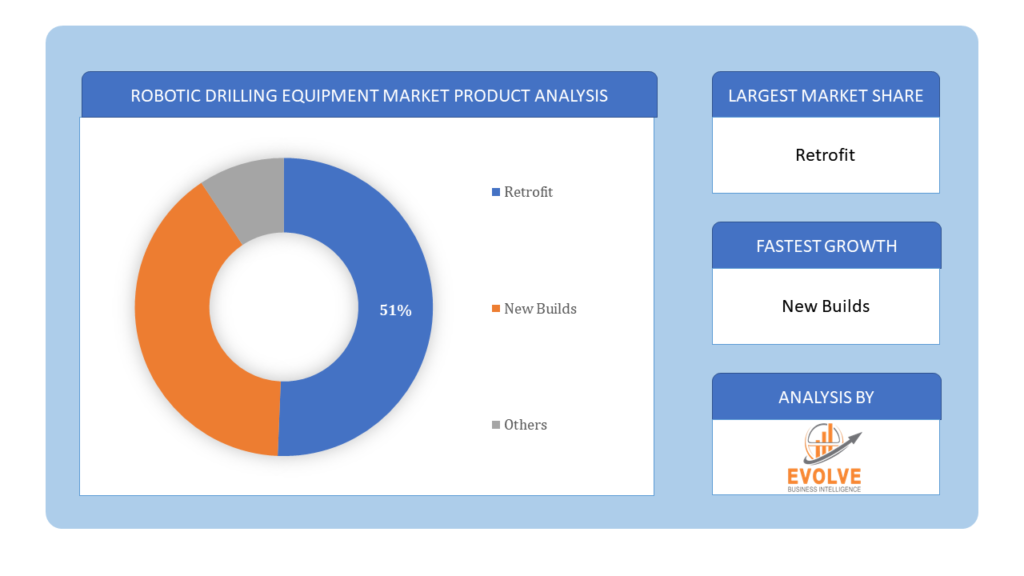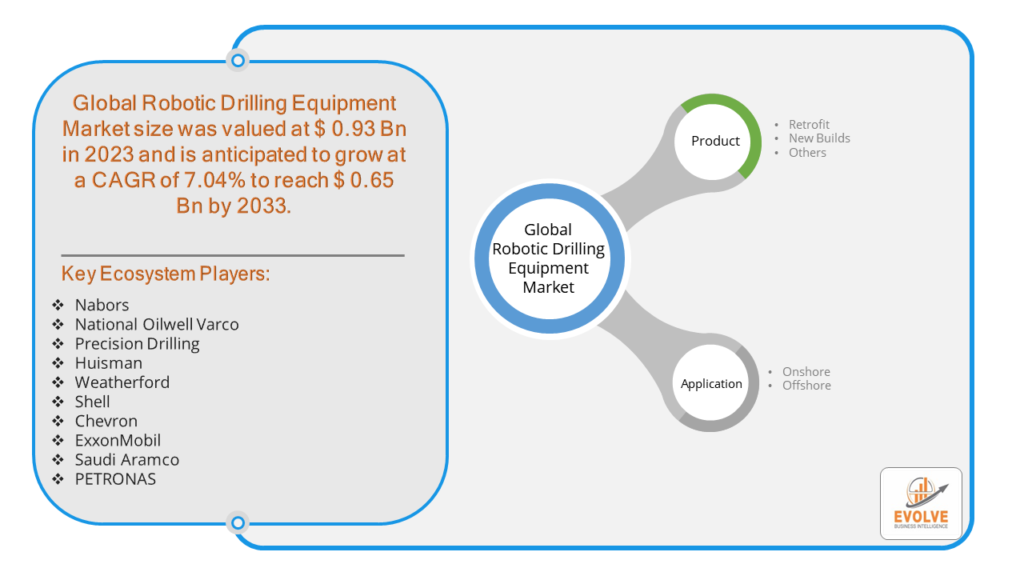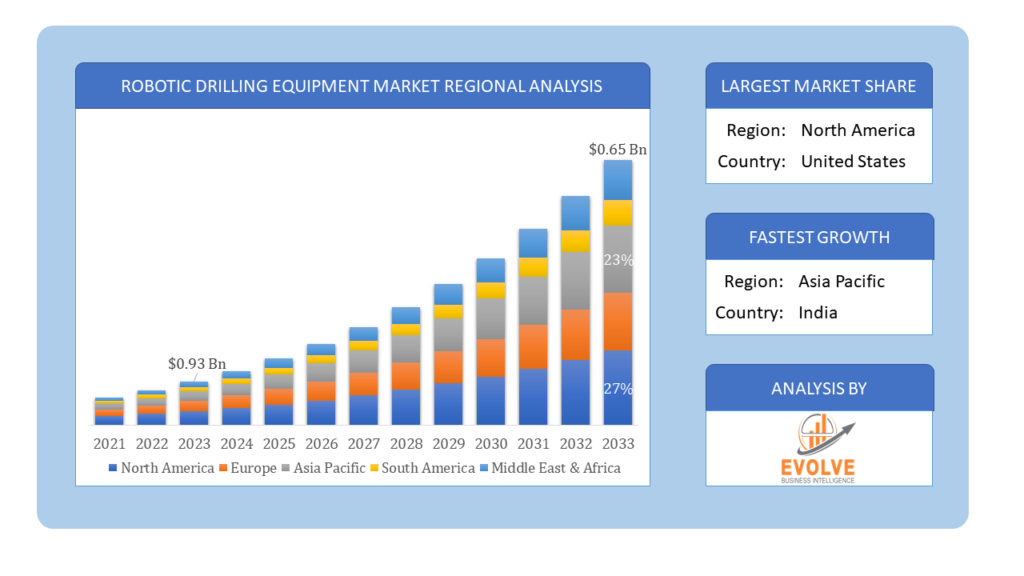Robotic Drilling Equipment Market Analysis and Global Forecast 2023-2033
$ 1,390.00 – $ 5,520.00Price range: $ 1,390.00 through $ 5,520.00
Robotic Drilling Equipment Market Research Report: Information By Installation (Retrofit, New Builds), By Application (Onshore, Offshore), and by Region — Forecast till 2033
Page: 165
Robotic Drilling Equipment Market Overview
The Robotic Drilling Equipment Market Size is expected to reach USD 0.65 Billion by 2033. The Robotic Drilling Equipment industry size accounted for USD 0.93 Billion in 2023 and is expected to expand at a compound annual growth rate (CAGR) of 7.04% from 2023 to 2033. The Robotic Drilling Equipment Market encompasses the development, manufacturing, and deployment of automated drilling systems used in oil and gas exploration. These systems utilize robotics and advanced technologies to enhance precision, safety, and efficiency in drilling operations. Key components include robotic drilling rigs, control systems, and software for automation and monitoring. The market is driven by the demand for reducing operational costs, minimizing human intervention, and improving drilling accuracy. Adoption of robotic drilling equipment is increasing due to advancements in technology, rising energy demands, and the need for safer, more efficient drilling practices.
Global Robotic Drilling Equipment Market Synopsis
The COVID-19 pandemic has led to supply chain disruptions leading to supply shortages or lower demand in the robotic drilling equipment market. The travel restrictions and social-distancing measures have resulted in a sharp drop in consumer and business spending and this pattern is to continue for some time. The end-user trend and preferences have changed due to the pandemic and have resulted in manufacturers, developers, and service providers adopting various strategies to stabilize the company.
Robotic Drilling Equipment Market Dynamics
The major factors that have impacted the growth of Robotic Drilling Equipment are as follows:
Drivers:
Ø Technological Advancements
Continuous innovations in robotics, AI, and sensor technologies are driving the market forward. These advancements enable real-time data collection, analysis, and decision-making, enhancing drilling accuracy and efficiency.
Restraint:
- High Initial Investment Costs
One of the primary barriers to the widespread adoption of robotic drilling equipment is the significant upfront investment required. The costs associated with acquiring, installing, and maintaining robotic systems can be prohibitive for many operators, particularly smaller companies or those with limited capital resources.
Opportunity:
⮚ Cost Efficiency and Operational Savings
Robotic drilling equipment offers significant opportunities for cost reduction and operational savings. Automation minimizes labor costs, enhances operational efficiency, and reduces downtime associated with human error, thereby improving overall project economics.
Robotic Drilling Equipment Segment Overview
By Product
 Based on Product, the market is segmented based on Retrofit, New Builds. the Retrofit segment currently dominates, as many existing drilling rigs are being upgraded with robotic technologies to enhance efficiency and safety, rather than solely focusing on new builds.
Based on Product, the market is segmented based on Retrofit, New Builds. the Retrofit segment currently dominates, as many existing drilling rigs are being upgraded with robotic technologies to enhance efficiency and safety, rather than solely focusing on new builds.
By Application
Based on Applications, the market has been divided into the Onshore, Offshore. the Onshore segment currently dominates, driven by the higher volume of onshore drilling activities globally compared to offshore operations.
Global Robotic Drilling Equipment Market Regional Analysis
Based on region, the global Robotic Drilling Equipment market has been divided into North America, Europe, Asia-Pacific, the Middle East & Africa, and Latin America. North America is projected to dominate the use of the Robotic Drilling Equipment market followed by the Asia-Pacific and Europe regions.
 Robotic Drilling Equipment North America Market
Robotic Drilling Equipment North America Market
North America holds a dominant position in the Robotic Drilling Equipment Market. In 2022, the North American robotic drilling market held a 45.80% market share. The Gulf of Mexico continues to be the primary location for offshore oil and gas production. Using robotic drilling technologies can improve these operations’ productivity and safety, which will appeal to local companies. In addition, the robotic drilling market in the United States had the most market share, while the robotic drilling market in Canada was expanding at the quickest rate on the North American continent.
Robotic Drilling Equipment Asia-Pacific Market
The Asia-Pacific region has indeed emerged as the fastest-growing market for the Robotic Drilling Equipment industry. From 2023 to 2032, the robotic drilling market in Asia-Pacific is anticipated to develop at the quickest rate of compound annual growth. Large-scale infrastructure projects, including as high-rise buildings, tunnels, and bridges, are well-known in the region. Robotic drilling can expedite these projects and boost overall production. Furthermore, the robotic drilling market in China had the most market share, while the robotic drilling market in India had the quickest rate of growth in the Asia-Pacific area.
Competitive Landscape
The global Robotic Drilling Equipment market is highly competitive, with numerous players offering a wide range of software solutions. The competitive landscape is characterized by the presence of established companies, as well as emerging startups and niche players. To increase their market position and attract a wide consumer base, the businesses are employing various strategies, such as product launches, and strategic alliances.
Prominent Players:
- Nabors
- National Oilwell Varco
- Precision Drilling
- Huisman
- Weatherford
- Shell
- Chevron
- ExxonMobil
- Saudi Aramco
- PETRONAS
Key Development
In September 2022, National Oilwell Varco (NOV) launched advanced robotic drilling systems aimed at improving drilling efficiency and reducing operational costs in the oil and gas industry.
Scope of the Report
Global Robotic Drilling Equipment Market, by Product
- Retrofit
- New Builds
- Others
Global Robotic Drilling Equipment Market, by Application
- Onshore
- Offshore
Global Robotic Drilling Equipment Market, by Region
- North America
- US
- Canada
- Mexico
- Europe
- UK
- Germany
- France
- Italy
- Spain
- Benelux
- Nordic
- Rest of Europe
- Asia Pacific
- China
- Japan
- South Korea
- Indonesia
- Austalia
- Malaysia
- India
- Rest of Asia Pacific
- South America
- Brazil
- Argentina
- Rest of South America
- Middle East & Africa
- Saudi Arabia
- UAE
- Egypt
- South Africa
- Rest of Middle East & Africa
| Parameters | Indicators |
|---|---|
| Market Size | 2033: $0.65Billion |
| CAGR | 7.04% CAGR (2023-2033) |
| Base year | 2022 |
| Forecast Period | 2023-2033 |
| Historical Data | 2021 |
| Report Coverage | Revenue Forecast, Competitive Landscape, Growth Factors, and Trends |
| Key Segmentations | Installation, Application |
| Geographies Covered | North America, Europe, Asia-Pacific, Latin America, Middle East, Africa |
| Key Vendors | Nabors, National Oilwell Varco, Precision Drilling, Huisman, Weatherford, Shell, Chevron, ExxonMobil, Saudi Aramco, PETRONAS |
| Key Market Opportunities | • Safety in Oil Rigs. |
| Key Market Drivers | • Increased Exploration Activities In Deep Water |
REPORT CONTENT BRIEF:
- High-level analysis of the current and future Robotic Drilling Equipment market trends and opportunities
- Detailed analysis of current market drivers, restraining factors, and opportunities in the future
- Robotic Drilling Equipment market historical market size for the year 2021, and forecast from 2023 to 2033
- Robotic Drilling Equipment market share analysis at each product level
- Competitor analysis with detailed insight into its product segment, Government & Defense strength, and strategies adopted.
- Identifies key strategies adopted including product launches and developments, mergers and acquisitions, joint ventures, collaborations, and partnerships as well as funding taken and investment done, among others.
- To identify and understand the various factors involved in the global Robotic Drilling Equipment market affected by the pandemic
- To provide a detailed insight into the major companies operating in the market. The profiling will include the Government & Defense health of the company’s past 2-3 years with segmental and regional revenue breakup, product offering, recent developments, SWOT analysis, and key strategies.
Press Release

Global Pharmaceutical Manufacturing Market to Reach $1.38 Trillion by 2035 with 7.35% CAGR, New Research Shows

The Global Mammography Market Is Estimated To Record a CAGR of Around 10.29% During The Forecast Period

Glue Stick Market to Reach USD 2.35 Billion by 2034

Podiatry Service Market to Reach USD 11.88 Billion by 2034

Microfluidics Technology Market to Reach USD 32.58 Billion by 2034

Ferric Chloride Market to Reach USD 10.65 Billion by 2034

Family Practice EMR Software Market to Reach USD 21.52 Billion by 2034

Electric Hairbrush Market to Reach USD 15.95 Billion by 2034

Daily Bamboo Products Market to Reach USD 143.52 Billion by 2034

Cross-border E-commerce Logistics Market to Reach USD 112.65 Billion by 2034
Frequently Asked Questions (FAQ)
1.What is the study period of this market?
- The study period of the global Robotic Drilling Equipment market is 2021- 2033
2.What is the growth rate of the global Robotic Drilling Equipment market?
- The global Robotic Drilling Equipment market is growing at a CAGR of 7.04% over the next 10 years
3.Which region has the highest growth rate in the market of Robotic Drilling Equipment?
- Asia Pacific is expected to register the highest CAGR during 2023-2033
4.Which region has the largest share of the global Robotic Drilling Equipment market?
- North America holds the largest share in 2022
5.Who are the key players in the global Robotic Drilling Equipment market?
Nabors, National Oilwell Varco, Precision Drilling, Huisman, Weatherford, Shell, Chevron, ExxonMobil, Saudi Aramco, and PETRONAS are the major companies operating in the market
6.Do you offer Post Sale Support?
- Yes, we offer 16 hours of analyst support to solve the queries
7.Do you sell particular sections of a report?
Yes, we provide regional as well as country-level reports. Other than this we also provide a sectional report. Please get in contact with our sales representatives
Table of Content
Chapter 1. Executive Summary Chapter 2. Scope Of The Study 2.1. Market Definition 2.2. Scope Of The Study 2.2.1. Objectives of Report 2.2.2. Limitations 2.3. Market Structure Chapter 3. Evolve BI Methodology Chapter 4. Market Insights and Trends 4.1. Supply/ Value Chain Analysis 4.1.1. Raw Applications Providers 4.1.2. Manufacturing Process 4.1.3. Distributors/Retailers 4.1.4. End-Use Industry 4.2. Porter’s Five Forces Analysis 4.2.1. Threat Of New Entrants 4.2.2. Bargaining Power Of Buyers 4.2.3. Bargaining Power Of Suppliers 4.2.4. Threat Of Substitutes 4.2.5. Industry Rivalry 4.3. Impact Of COVID-19 on the Robotic Drilling Equipment Market 4.3.1. Impact on Market Size 4.3.2. End-Use Industry Trend, Preferences, and Budget Impact 4.3.3. Regulatory Framework/Government Policies 4.3.4. Key Players' Strategy to Tackle Negative Impact 4.3.5. Opportunity Window 4.4. Technology Overview 12.28. Macro factor 4.6. Micro Factor 4.7. Demand Supply Gap Analysis of the Robotic Drilling Equipment Market 4.8. Import Analysis of the Robotic Drilling Equipment Market 4.9. Export Analysis of the Robotic Drilling Equipment Market Chapter 5. Market Dynamics 5.1. Introduction 5.2. DROC Analysis 5.2.1. Drivers 5.2.2. Restraints 5.2.3. Opportunities 5.2.4. Challenges 5.3. Patent Analysis 5.4. Industry Roadmap 5.5. Parent/Peer Market Analysis Chapter 6. Global Robotic Drilling Equipment Market, By Installation 6.1. Introduction 6.2. Retrofit 6.3. New Builds 6.4. Others Chapter 7. Global Robotic Drilling Equipment Market, By Application 7.1. Introduction 7.2. Onshore 7.3. Offshore Chapter 8. Global Robotic Drilling Equipment Market, By Region 8.1. Introduction 8.2. North America 8.2.1. Introduction 8.2.2. Driving Factors, Opportunity Analyzed, and Key Trends 8.2.3. Market Size and Forecast, By Country, 2023-2033 8.2.4. Market Size and Forecast, By Installation, 2023-2033 8.2.5. Market Size and Forecast, By Application, 2023-2033 8.2.6. US 8.2.6.1. Introduction 8.2.6.2. Driving Factors, Opportunity Analyzed, and Key Trends 8.2.6.3. Market Size and Forecast, By Installation, 2023-2033 8.2.6.4. Market Size and Forecast, By Application, 2023-2033 8.2.7. Canada 8.2.7.1. Introduction 8.2.7.2. Driving Factors, Opportunity Analyzed, and Key Trends 8.2.7.4. Market Size and Forecast, By Installation, 2023-2033 8.2.7.5. Market Size and Forecast, By Application, 2023-2033 8.3. Europe 8.3.1. Introduction 8.3.2. Driving Factors, Opportunity Analyzed, and Key Trends 8.3.3. Market Size and Forecast, By Country, 2023-2033 8.3.4. Market Size and Forecast, By Installation, 2023-2033 8.3.5. Market Size and Forecast, By Application, 2023-2033 8.3.6. Germany 8.3.6.1. Introduction 8.3.6.2. Driving Factors, Opportunity Analyzed, and Key Trends 8.3.6.3. Market Size and Forecast, By Installation, 2023-2033 8.3.6.4. Market Size and Forecast, By Application, 2023-2033 8.3.7. France 8.3.7.1. Introduction 8.3.7.2. Driving Factors, Opportunity Analyzed, and Key Trends 8.3.7.3. Market Size and Forecast, By Installation, 2023-2033 8.3.7.4. Market Size and Forecast, By Application, 2023-2033 8.3.8. UK 8.3.8.1. Introduction 8.3.8.2. Driving Factors, Opportunity Analyzed, and Key Trends 8.3.8.3. Market Size and Forecast, By Installation, 2023-2033 8.3.8.4. Market Size and Forecast, By Application, 2023-2033 8.3.9. Italy 8.3.9.1. Introduction 8.3.9.2. Driving Factors, Opportunity Analyzed, and Key Trends 8.3.9.3. Market Size and Forecast, By Installation, 2023-2033 8.3.9.4. Market Size and Forecast, By Application, 2023-2033 8.3.11. Rest Of Europe 8.3.11.1. Introduction 8.3.11.2. Driving Factors, Opportunity Analyzed, and Key Trends 8.3.11.3. Market Size and Forecast, By Installation, 2023-2033 8.3.11.4. Market Size and Forecast, By Application, 2023-2033 8.4. Asia-Pacific 8.4.1. Introduction 8.4.2. Driving Factors, Opportunity Analyzed, and Key Trends 8.4.3. Market Size and Forecast, By Country, 2023-2033 8.4.4. Market Size and Forecast, By Installation, 2023-2033 8.12.28. Market Size and Forecast, By Application, 2023-2033 8.4.6. China 8.4.6.1. Introduction 8.4.6.2. Driving Factors, Opportunity Analyzed, and Key Trends 8.4.6.3. Market Size and Forecast, By Installation, 2023-2033 8.4.6.4. Market Size and Forecast, By Application, 2023-2033 8.4.7. India 8.4.7.1. Introduction 8.4.7.2. Driving Factors, Opportunity Analyzed, and Key Trends 8.4.7.3. Market Size and Forecast, By Installation, 2023-2033 8.4.7.4. Market Size and Forecast, By Application, 2023-2033 8.4.8. Japan 8.4.8.1. Introduction 8.4.8.2. Driving Factors, Opportunity Analyzed, and Key Trends 8.4.8.3. Market Size and Forecast, By Installation, 2023-2033 8.4.8.4. Market Size and Forecast, By Application, 2023-2033 8.4.9. South Korea 8.4.9.1. Introduction 8.4.9.2. Driving Factors, Opportunity Analyzed, and Key Trends 8.4.9.3. Market Size and Forecast, By Installation, 2023-2033 8.4.9.4. Market Size and Forecast, By Application, 2023-2033 8.4.10. Rest Of Asia-Pacific 8.4.10.1. Introduction 8.4.10.2. Driving Factors, Opportunity Analyzed, and Key Trends 8.4.10.3. Market Size and Forecast, By Installation, 2023-2033 8.4.10.4. Market Size and Forecast, By Application, 2023-2033 8.5. Rest Of The World (RoW) 8.5.1. Introduction 8.5.2. Driving Factors, Opportunity Analyzed, and Key Trends 8.5.3. Market Size and Forecast, By Installation, 2023-2033 8.5.4. Market Size and Forecast, By Application, 2023-2033 Chapter 9. Company Landscape 9.1. Introduction 9.2. Vendor Share Analysis 9.3. Key Development Analysis 9.4. Competitor Dashboard Chapter 10. Company Profiles 10.1. Nabors 10.1.1. Business Overview 10.1.2. Government & Defense Analysis 10.1.2.1. Government & Defense – Existing/Funding 10.1.3. Product Portfolio 10.1.4. Recent Development and Strategies Adopted 10.1.5. SWOT Analysis 10.2. National Oilwell Varco 10.2.1. Business Overview 10.2.2. Government & Defense Analysis 10.2.2.1. Government & Defense – Existing/Funding 10.2.3. Product Portfolio 10.2.4. Recent Development and Strategies Adopted 10.2.5. SWOT Analysis 10.3. Precision Drilling 10.3.1. Business Overview 10.3.2. Government & Defense Analysis 10.3.2.1. Government & Defense – Existing/Funding 10.3.3. Product Portfolio 10.3.4. Recent Development and Strategies Adopted 10.3.5. SWOT Analysis 10.4. Huisman 10.4.1. Business Overview 10.4.2. Government & Defense Analysis 10.4.2.1. Government & Defense – Existing/Funding 10.4.3. Product Portfolio 10.4.4. Recent Development and Strategies Adopted 10.12.28. SWOT Analysis 10.5. Weatherford 10.5.1. Business Overview 10.5.2. Government & Defense Analysis 10.5.2.1. Government & Defense – Existing/Funding 10.5.3. Product Portfolio 10.5.4. Recent Development and Strategies Adopted 10.5.5. SWOT Analysis 10.6. Shell 10.6.1. Business Overview 10.6.2. Government & Defense Analysis 10.6.2.1. Government & Defense – Existing/Funding 10.6.3. Product Portfolio 10.6.4. Recent Development and Strategies Adopted 10.6.5. SWOT Analysis 10.7. Chevron 10.7.1. Business Overview 10.7.2. Government & Defense Analysis 10.7.2.1. Government & Defense – Existing/Funding 10.7.3. Product Portfolio 10.7.4. Recent Development and Strategies Adopted 10.7.5. SWOT Analysis 10.8 ExxonMobil 10.8.1. Business Overview 10.8.2. Government & Defense Analysis 10.8.2.1. Government & Defense – Existing/Funding 10.8.3. Product Portfolio 10.8.4. Recent Development and Strategies Adopted 10.8.5. SWOT Analysis 10.9 Saudi Aramco 10.9.1. Business Overview 10.9.2. Government & Defense Analysis 10.9.2.1. Government & Defense – Existing/Funding 10.9.3. Product Portfolio 10.9.4. Recent Development and Strategies Adopted 10.9.5. SWOT Analysis 10.10. PETRONAS 10.10.1. Business Overview 10.10.2. Government & Defense Analysis 10.10.2.1. Government & Defense – Existing/Funding 10.10.3. Product Portfolio 10.10.4. Recent Development and Strategies Adopted 10.10.5. SWOT Analysis
Connect to Analyst
Research Methodology








